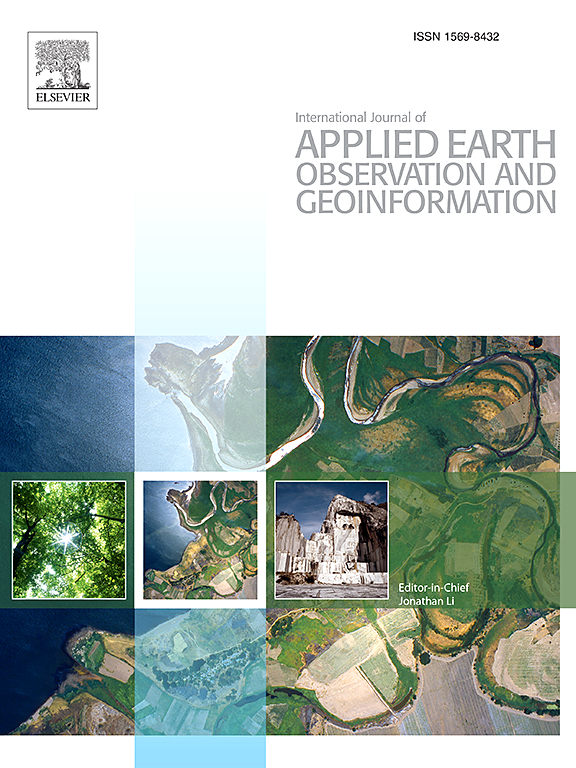Unlocking the InSAR potential for managing underground gas storage in salt caverns
IF 8.6
Q1 REMOTE SENSING
International journal of applied earth observation and geoinformation : ITC journal
Pub Date : 2025-06-06
DOI:10.1016/j.jag.2025.104656
引用次数: 0
Abstract
Natural gas plays a key role in the ongoing transition to renewable energy, bridging the gap between conventional fossil fuels and cleaner alternatives. Despite the increasing emphasis on renewables, total reliance on electricity is still out of reach today, necessitating a transition period. The role of natural gas is particularly evident in addressing the challenges posed by seasonal fluctuations in consumption, a persistent issue for the global energy industry. In this context, Underground Gas Storage (UGS) facilities offer a flexible strategy to create global reserves and stabilise supply against demand fluctuations. Among the exploitable geological structures that are available for UGS, underground salt caverns allow high injection and withdrawal rates. However, these operations can induce subsidence due to cavern convergence and seasonal ground displacement resulting from operational cycles. This study employs multi-temporal Interferometric Synthetic Aperture Radar (InSAR) analysis, using Sentinel-1 data and the SqueeSAR algorithm, to monitor surface displacement at two UGS sites in Lower Saxony, Germany. The analysis revealed a vertical displacement velocity of up to 28 mm/year, forming a distinct cone-shaped deformation. Time series analysis showed a strong correlation between the injection/withdrawal cycles and the InSAR data. The threshold method identified UGS affected areas, offering a standardised framework for UGS monitoring. The study also introduced the RTK cross-correlation analysis to refine displacement interpretations, enhancing the ability to isolate gas storage induced deformation from unrelated surface processes. These results contribute for optimising injection and withdrawal strategies, mitigating subsidence risks and allowing the long-term sustainability of UGS operations. This approach can support robust management practices that prioritise safety and operational efficiency.
释放InSAR在管理盐穴地下储气库方面的潜力
天然气在向可再生能源的持续过渡中发挥着关键作用,弥合了传统化石燃料和更清洁替代品之间的差距。尽管越来越重视可再生能源,但完全依赖电力在今天仍然遥不可及,因此需要一个过渡期。天然气在应对消费季节性波动带来的挑战方面的作用尤为明显,消费季节性波动是全球能源行业的一个长期问题。在这种情况下,地下储气库(UGS)设施提供了一种灵活的策略,可以创建全球储备,并在需求波动时稳定供应。在可用于UGS的可开采地质构造中,地下盐洞允许高注入和抽采速率。然而,这些作业可能会由于洞穴的收敛和作业周期造成的季节性地面位移而引起沉降。本研究采用多时相干涉合成孔径雷达(InSAR)分析,利用Sentinel-1数据和SqueeSAR算法,监测德国下萨克森州两个UGS站点的地表位移。分析显示,垂直位移速度高达28mm /年,形成了明显的锥形变形。时间序列分析显示,注入/提取周期与InSAR数据之间存在很强的相关性。阈值法确定了UGS受影响的区域,为UGS监测提供了标准化框架。该研究还引入了RTK相互关联分析来改进位移解释,提高了将储气引起的变形与不相关的地面过程隔离的能力。这些结果有助于优化注入和回收策略,降低下沉风险,并允许UGS的长期可持续性运行。这种方法可以支持健壮的管理实践,优先考虑安全性和操作效率。
本文章由计算机程序翻译,如有差异,请以英文原文为准。
求助全文
约1分钟内获得全文
求助全文
来源期刊

International journal of applied earth observation and geoinformation : ITC journal
Global and Planetary Change, Management, Monitoring, Policy and Law, Earth-Surface Processes, Computers in Earth Sciences
CiteScore
12.00
自引率
0.00%
发文量
0
审稿时长
77 days
期刊介绍:
The International Journal of Applied Earth Observation and Geoinformation publishes original papers that utilize earth observation data for natural resource and environmental inventory and management. These data primarily originate from remote sensing platforms, including satellites and aircraft, supplemented by surface and subsurface measurements. Addressing natural resources such as forests, agricultural land, soils, and water, as well as environmental concerns like biodiversity, land degradation, and hazards, the journal explores conceptual and data-driven approaches. It covers geoinformation themes like capturing, databasing, visualization, interpretation, data quality, and spatial uncertainty.
 求助内容:
求助内容: 应助结果提醒方式:
应助结果提醒方式:


